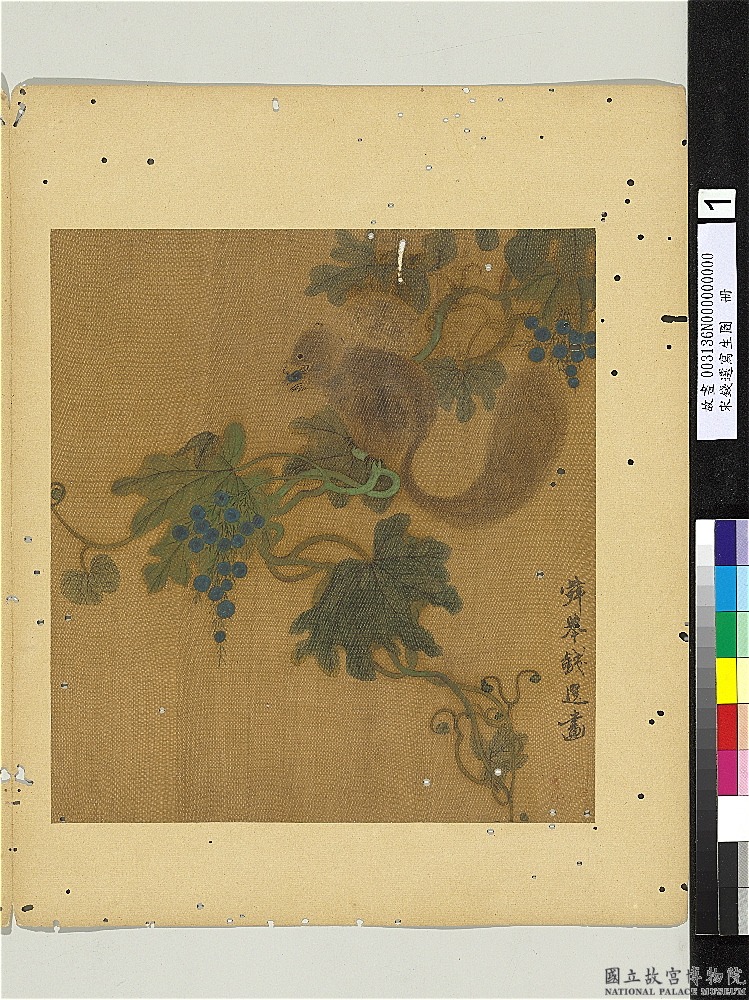
Picture credit: The Palace Museum, Beijing (https://www.dpm.org.cn/collection/paint/231318.html)
Inscription:
半生落魄已成翁,
獨立書齋嘯晚風。
筆底明珠無處賣,
閒抛閒擲野藤中。[1]
天池。
Having been down and out for half of my life, [I] have become an old man,
Standing in my studio alone, letting out a long sigh in the evening wind.
The luminous pearls on the tip of my brush, with nowhere to be sold,
Are scattered and abandoned casually among the wild vines.
By Heavenly Pond[2]
Seal:
湘管齋 (Xiang-Tube Studio): Xu Wei’s personal seal dedicated to a precious, broken brush made from Xiang bamboo.[3]
Note:
As one of the towering figures in the history of Chinese art and literature, Xu Wei 徐渭 (1521-1593) is known for his expressive style. Indeed, the bold, free brushwork in this painting distinguishes him from many other artists before and after him. Whereas grapes are often depicted with a squirrel to symbolise an abundance of descendants in auspicious paintings, Xu Wei disregards this artistic convention and uses the plant to express something completely different, a sense of sombre solitude.
According to Xu Wei’s verdict on his own talents, he considered his “calligraphy the best, poems second, prose third, and painting fourth (書第一, 詩二, 文三, 畫四).”[4] We thus have good reasons to believe that he would have urged the viewer of his painting to savour the text and calligraphy of his inscription at the same time.
[1] Red characters rhyme. [2] “Heavenly Pond” is one of Xu Wei’s style names. [3] See Xu Wei’s poem “Xiangzhu yi miaoguan fu jiehuai qi dingwen” 湘竹一妙管付截壞其頂文 on this incident in Xu Wenchang wenji 徐文長文集: https://ctext.org/library.pl?if=en&file=38715&page=71. [4] See Xu Wei’s biography by his countryman Tao Wangling 陶望齡 (1562-1609) in Xu Wenchang quanji 徐文長全集 (Shanghai: Guangyi shuju, 1936), 4.
A few examples of traditional "The squirrel and grapes" paintings:
1. “Putao songshu” 葡萄松鼠 by Qian Xuan 錢選 (1239-1299)
Picture credit: National Palace Museum, Taipei
2. “Putao songshu” 葡萄松鼠by Zhou Zhimian 周之冕 (b. 1521)
Picture credit: National Palace Museum, Taipei
3. “Songshu putao” 松鼠葡萄 by Liu Deliu 劉德六 (1806-1875)
Picture credit: The Metropolitan Museum of Art
4. “Songshu putao” 松鼠葡萄 by Sha Fu 沙馥 (1830-1906)
Picture credit: The Metropolitan Museum of Art
Copyright Declaration*:
The texts and images used on the website of Rachelle's Lab are either from the public domain (e.g. Wikipedia), databases with open data licences (e.g. Shuhua diancang ziliao jiansuo xitong 書畫典藏資料檢索系統, National Palace Museum, Taipei), online libraries that permit reasonable use (e.g. ctext.org), or original work created for this website.
Although fair use of the website for private non-profit purposes is permitted, please note that the website of Rachelle's Lab and its content (including but not limited to translations, blog posts, images, videos, etc.) are protected under international copyright law. If you want to republish, distribute, or make derivative work based on the website content, please contact me, the copyright owner, to get written permission first and make sure to link to the corresponding page when you use it.
版權聲明:
本站所使用的圖片,皆出自公有領域(如維基)、開放數據庫(如臺北故宮博物院書畫典藏資料檢索系統)、允許合理引用的在線圖書館(如中國哲學電子化計劃)及本人創作。本站允許對網站內容進行個人的、非營利性質的合理使用。但請注意,本站及其內容(包括但不限於翻譯、博文、圖像、視頻等)受國際版權法保護。如需基於博客內容進行出版、傳播、製作衍生作品等,請務必先徵求作者(本人)書面許可,并在使用時附上本站鏈接,註明出處。
*Read more about copyright and permission here.








